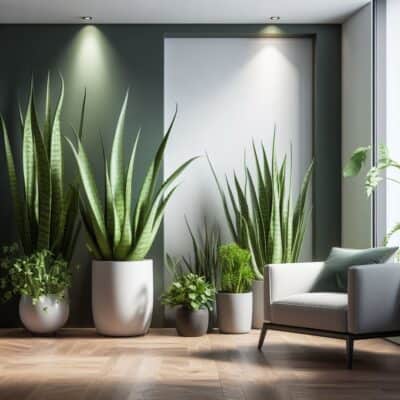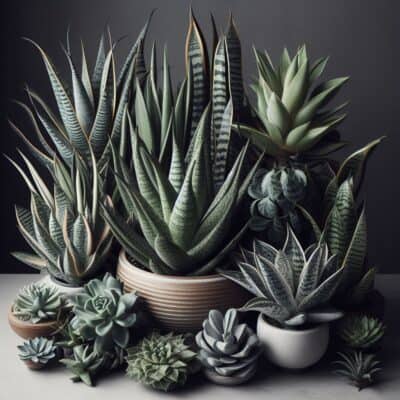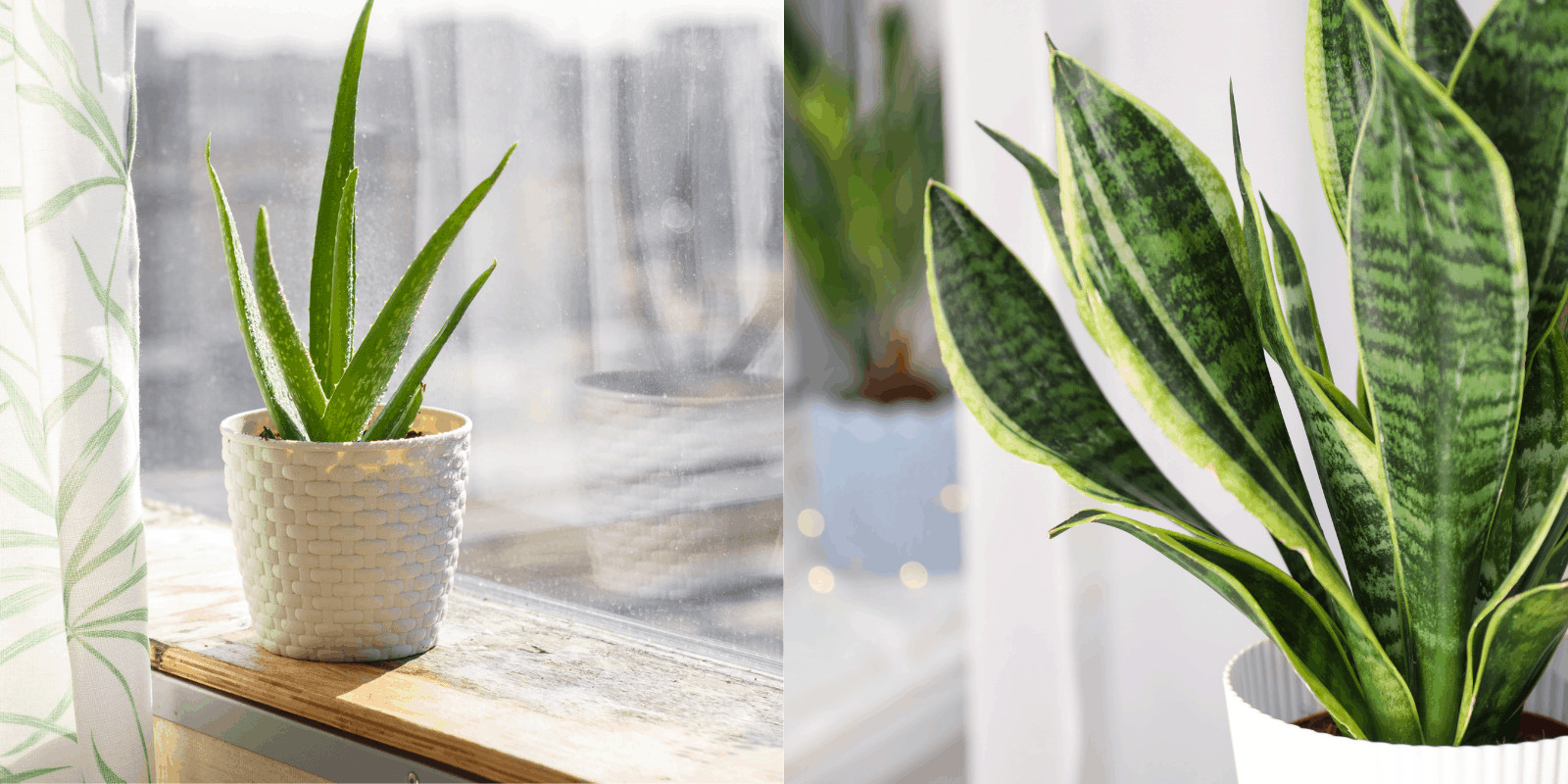
According to Indoor Mint, aloe vera is a great companion plant for snake plants.
Aloe vera and snake plants differ in appearance. (1)
Aloe vera has longer leaves and a more vibrant green color, while snake plants have shorter and thicker leaves with a variegated pattern.
If you’re interested in learning more about the differences between these two plants, keep reading.
KEY TAKEAWAY
Aloe vera and snake plant differences, what to know?
Aloe vera and snake plants differ in various aspects, from their appearance to care requirements.
While aloe vera is renowned for its healing properties, snake plants excel in air purification, making each a unique and beneficial addition to your green space.
Unlocking the Secrets: Aloe Vera and Snake Plant Differences Revealed
When it comes to aloe vera and snake plants, it’s easy to see some similarities – both have striking green leaves and can purify indoor air.
However, they have some key differences that set them apart.
Snake plants, also known as sansevieria trifasciata, have tall, stiff leaves with striking yellow and light green striped patterns.
Aloe vera leaves are thicker, fatter, and have serrated edges, almost like the teeth of a saw.
They also produce a clear gel used for skincare.
While snake plants need only occasional watering and can thrive even in low indoor light, aloe vera requires more frequent watering about every three weeks and appreciates indirect sunlight from a bright window.
Snake plants also produce oxygen at night, whereas aloe Vera does not.
When choosing between these useful indoor plants, consider whether you want a bold architectural look (snake plants) or a succulent that doubles as a home remedy (aloe vera).
Both purify air, but snake plants are more low maintenance and drought resistant.
Green Allies: Aloe Vera vs Snake Plant – Which is Your Perfect Match?
Choosing the right indoor plant ally can make your home healthier and happier.
Should it be an aloe vera (2) or a snake plant? Here’s how to pick your perfect green friend:
If you want a living first aid kit, aloe vera is for you.
This succulent stores gel in its leaves that can soothe minor burns, cuts, skin irritation and support immunity – a hands-on way to reap health benefits.
Since aloe requires more frequent watering, it’s better for gardeners who enjoy nurturing plants.
For low maintenance growers or frequently traveling plant parents, dependable snake plants are ideal.
Snake plants need water only once a month and tolerate both neglect and low light levels that kill other plants.
Their bold, upright leaves effortlessly make a statement while filtering indoor toxins.
Set it and nearly forget it!
Before bringing one of these helpful plants that look like aloe home, ensure you can provide the proper growing conditions.
Fortunately both adapt well indoors, purifying your air while asking little in return with their resilience.
Simply choose which special qualities you want most, and let these hardy green allies brighten your living space.
In the Spotlight: Aloe Vera’s Healing Touch vs. Snake Plant’s Air-Purifying Prowess

Aloe vera is well-known for its healing properties.
This succulent plant has been used for centuries to treat burns, wounds, and other skin conditions.
Its gel contains active compounds that help reduce inflammation and stimulate cell regeneration.
On the other hand, the snake plant is an expert at purifying indoor air.
With its stiff, upright leaves, it can effectively remove toxins like formaldehyde and benzene from the environment.
Unlike aloe vera, the snake plant offers preventative health benefits by tackling indoor air pollution.
Both plants provide wellness advantages indoors.
While aloe vera lends its remedial powers, snake plant makes for cleaner breathing.
Their unique benefits make them helpful additions to any bright, indirect lit space.
Aloe Vera’s Thirst vs. Snake Plant’s Sip: Decoding Watering Mysteries
Getting their water needs right can be tricky for beginners.
Aloe vera stores water in its succulent leaves, so it can tolerate some drought.
But it thrives when soil moisture is maintained.
Water when the top inches become dry, taking care not to overwater.
Snake plants, with their waxy leaves, are even more drought-resistant.
Allow the soil to dry out completely between waterings.
Their preference for neglect can lead to overwatering issues.
Both plants give clues when thirsty, so an attentive eye is key!
Follow their cues and you’ll unlock their secrets to lush growth with minimal fuss.
Master their unique watering needs, and these low maintenance plants will flourish indoors!
Plant Lookalikes: Aloe Vera Imposters and Snake Plant Doppelgängers

With its distinctive fat leaves and healing reputation, aloe vera is often imitated.
Plants like the corn plant, haworthia, and gasteria offer imposter versions of those giveaway fleshy leaves.
While they make nice houseplants, they lack aloe’s medicinal properties.
Meanwhile, snake plant varieties like mother-in-law’s tongue or Saint George’s sword draw lookalike confusion.
Learn to spot key differences like leaf shape, height, and growth habit.
This helps ensure you pick the perfect detoxifying snake plant for your needs.
Home Harmony: Integrating Aloe Vera and Snake Plants in Your Living Space
Known for their easygoing natures, aloe vera and snake plants blend seamlessly into home environments.
Place them together on window sills to capitalize on their complementary air purifying strengths.
Or use snake plants to architecturally anchor a room while aloe vera adds a natural healing accent.
Get creative with containers too! Pair your snake plant with a woven basket or bright pot.
Experiment with an aloe-filled teacup planter or mini watering can.
With the right care requirements met, these plants invite endlessly artistic presentations fit for any personal paradise.
Let them inspire the possibilities!
Beyond Greenery: Aloe Vera and Snake Plants in Feng Shui

In Feng Shui, placing certain plants in the home is believed to promote positive energy flow.
The aloe vera, with its healing reputation and slender leaves, is thought to bring good health.
Its vibrant energy activates stagnant spaces.
Similarly, the upright dramatic leaves of the snake plant symbolize strength and vitality.
Known for purifying the air of toxic pollutants, its presence filters out negativity.
Together, an aloe vera and snake plant make a dynamic duo.
The snake plant builds protective energy, while the aloe invites in positive chi.
For an optimally balanced space, consider adding this botanical pair! With their air cleaning and decorative charm, they sustain spaces energetically and visually.
Frequently Asked Questions
What are some key differences between aloe vera and snake plants?
Aloe vera and snake plants, also known as mother-in-law’s tongue, are two very popular low maintenance succulent plants.
Some key differences between the two include their shaped leaves, light and water requirements, and maximum heights.
Do aloe vera and snake plants produce flowers?
Both aloe vera and snake plants can produce flowers under the right conditions.
Aloe veras will produce bright orange or yellow racemes or spiky clusters of tubular flowers.
Snake plants bloom small, white flowers on tall stalks.
Which plant does better with low indirect light versus bright light?
Aloe vera and snake plants are known to be very drought tolerant and able to thrive in low light conditions.
However, snake plants tend to do a bit better with low indirect light while aloe veras may appreciate a little more bright, direct light to prevent their leaves from becoming leggy.
How frequently do the plants need to be watered?
Due to their drought tolerant succulent properties, both aloe vera and snake plants only need watering about once every 1-2 weeks when the top inch or so of potting mix is dry.
Overwatering can cause root rot, so allowing the soil to dry out completely between waterings is best.
What type of potting mix and drainage is recommended?
For both plants, a well-draining potting mix such as a cactus/succulent or regular potting mix blended with perlite or gravel is recommended.
It’s also important to use pots with drainage holes to prevent roots from sitting in soggy soil.
How tall do aloe vera and snake plants typically grow?
Mature aloe vera plants can reach heights between 1-3 feet tall depending on the variety.
Snake plants, on the other hand, are typically shorter, maxing out at around 2-3 feet tall for most cultivars.
Conclusion
Though similar-looking, aloe vera and snake plants serve different purposes.
Aloe soothes skin with its gel; snake plant filters indoor air.
Aloe needs consistent moisture; snake plants thrive on neglect.
While aloe offers remedial healing, the snake plant prevents sickness by removing toxins.
Together they sustain wellness: aloe by treating ailments, snake plant by promoting clean, healthy environments.
Let this dynamic duo bring their complementary powers to your living space.
Then comment below on your experiences growing these helpful houseplants!
References
- https://indoormint.com/snake-plant-companion-plants/
- https://www.nccih.nih.gov/health/aloe-vera
Related Articles
- https://allthingsgardener.com/poisonous-snake-plant/
- https://allthingsgardener.com/houseplants-for-windowless-rooms/
- https://allthingsgardener.com/slow-growing-indoor-plants/


